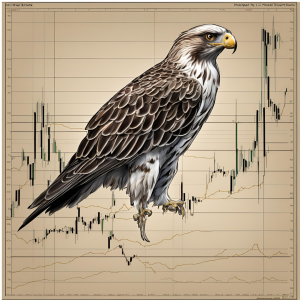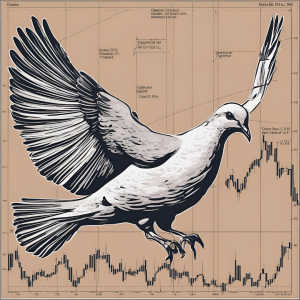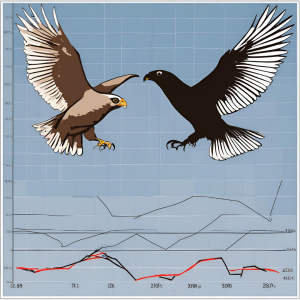Inflation and growth are directly linked as strong economic growth leads to higher inflation. To ensure that prices in an economy do not rapidly rise, banking officials make use of the hawkish or dovish policy to strike the right balance between the two. Both policies affect forex trading by enabling traders to shift to currencies that are favoured by the policies.
In our article, we will understand Hawkish vs Dovish from a forex perspective and how they affect the forex market in general.
What does hawkish mean?

Hawkish is a contractionary monetary policy in which central banks increase interest rates to lower the country’s money supply. A rise in interest rate directly increases the country’s currency value in the forex market as higher interest rates attract more foreign investment that increases demand for the country’s currency. The appreciation of the currency in the forex market leads to a rise in demand for the particular currency pair, in turn increasing the currency value even further.
What does dovish mean?

Dovish is an expansionary monetary policy in which central banks decrease interest rates to increase the country’s money supply. A fall in interest rate directly decreases the country’s currency value in the forex market as lower interest rates signal a pessimistic economic growth. As a result, foreign direct investments fall, and so does the demand for the country’s currency. The fall in demand due to currency depreciation leads to a further fall in the currency’s value.
Hawkish VS Dovish: The Key Differences
1. Implementation
A hawkish policy is followed when inflation is high, and so is the economic growth with a strengthened currency value. To curb the rising prices, interest rates are increased so that the inflation rate comes back under the central bank’s target level. This also results in a further increase in the home country’s currency value.
A dovish policy is followed when inflation is low, and so is the economic growth with a weakened currency value. To fight the dropping prices, interest rates are decreased so that the inflation comes back to the level decided by the central bank. This also results in a further decrease in the home country’s currency value.
2. Impact on forex prices
The hawkish policy is favourable from a currency value’s perspective as it increases the exchange rate and strengthens the currency in the forex market.
The dovish policy is not favourable from a currency value’s perspective as it decreases the exchange rate and weakens the currency in the forex market. However, it is favourable from a shorting perspective as traders can short trades (borrow funds to buy a currency pair at an exchange rate and sell them immediately before buying them back at a lower rate and returning them to the lender, keeping the difference in the rates as a profit) after a dovish policy is implemented.
3. Trading behaviours
Hawks are the traders who view rising inflation as a severe threat to the economy, and hence they are supporters of tight monetary policies. Such traders mostly invest in currencies of countries with strong economic growth and high inflation, with an expectation of the country imposing a contractionary monetary policy that will lead to a decrease in inflation, strengthened economic growth and increased exchange rates.
Doves are the traders who do not view falling inflation as an alarm but believe that quantitative easing is going to be beneficial for the economy. Hence, they support expansionary monetary policies and invest in falling currencies by shorting the trades.
Traders open short positions in currencies of countries with slow economic growth and low inflation, with an expectation of the expansionary monetary policy leading to a rise in inflation, better economic growth and a further fall in the exchange rate.
4. Philosophy
Hawkish stances prioritize controlling inflation through tighter monetary policy and higher interest rates.
However, dovish stances prioritize economic growth and employment, often favoring looser monetary policy and lower interest rates.
5. Central bank communication
In a hawkish market, central bank statements signal concerns about inflation and suggest readiness for rate hikes or policy tightening.
Meanwhile, in dovish markets, central bank communications emphasize support for economic growth and may hint at potential rate cuts or continued stimulus measures.
6. Impact on carry trades
Hawkish means a stance having a negative impact on carry trades as higher interest rates decrease the gains of carry trades.
In dovish vs hawkish, the former has a positive impact on carry trades as lower interest rates encourage carry trades due to the potential for cheaper borrowing costs.
7. Volatility
In hawkish markets, policy shifts towards tightening can lead to increased volatility as markets adjust to higher interest rates.
Similarly, unexpected shifts towards loosening policy can spur volatility as markets anticipate economic stimulus measures.
Tips to trade the dovish vs hawkish market
Focus on interest rate differentials
In a dovish market, where central banks are likely to lower interest rates or maintain them at low levels, traders can focus on currencies with relatively higher interest rates. They may seek to go long on currencies from countries expected to maintain or raise interest rates, as these currencies may appreciate against those with lower rates.
Conversely, in a hawkish market, where central banks are inclined to raise interest rates, traders may monitor interest rate differentials to identify opportunities. They might consider going long on currencies with expected rate hikes, as these currencies may strengthen relative to those with stable or declining rates.
Consider options strategies
Options strategies can be employed to hedge against downside risk or to capitalize on potential volatility resulting from central bank stimulus measures. Traders might consider using options to protect against adverse currency movements or to speculate on market direction following dovish policy announcements.
Similarly, Options strategies can also be beneficial in a hawkish market to manage risk and capture potential opportunities. Traders may utilize options to navigate uncertainty surrounding interest rate hikes or to capitalize on expected market movements triggered by hawkish policy decisions.
Implement yield curve analysis
Yield curve analysis can help traders assess market expectations regarding future interest rates and economic conditions. A flattening or inverted yield curve may signal economic concerns in a dovish market, where interest rates are anticipated to remain low or decrease further. Traders might adjust their positions based on such insights.
However, in a hawkish market, where interest rates are expected to rise, a steepening yield curve may indicate optimism about economic growth. Traders may interpret this as a signal to position for potential currency appreciation in countries with higher interest rates.
React to central bank stimulus measures
Traders should closely monitor central bank stimulus measures, such as interest rate cuts or quantitative easing programs, in a dovish market. These measures can impact currency valuations and market sentiment. Traders may adjust their positions accordingly, such as going long on riskier assets or currencies making gains from monetary stimulus.
In a hawkish market, where central banks are expected to reduce stimulus measures or tighten monetary policy, traders should be prepared to react to policy announcements that could influence market dynamics. This may involve adjusting positions to account for potential shifts in interest rates or market sentiment.
Focus on carry trades
Carry trades involve borrowing in currencies with low interest rates and investing in currencies with higher rates to capture the interest rate differential. In a dovish market environment with low interest rates, traders may engage in carry trades to earn yield from higher-yielding currencies, potentially leading to capital appreciation.
On the other hand, carry trades can also be attractive in a hawkish market, particularly if interest rate differentials widen due to expected rate hikes. Traders may exploit carry trade opportunities by going long on currencies with higher interest rates, potentially benefiting from capital inflows seeking higher returns.
Consider emerging market currencies
Emerging market currencies may exhibit heightened volatility in a dovish market, as they are often sensitive to changes in global monetary policy and risk sentiment. Traders might consider emerging market currencies with stronger fundamentals or higher interest rates as potential opportunities for investment or speculation.
Similarly, in a hawkish market, traders may assess emerging market currencies for potential dovish and hawkish trading opportunities. They might look for currencies with attractive interest rate differentials or improving economic fundamentals that could increase currency appreciation.
How to trade in a hawkish vs dovish market
Monitor economic data
Look for indicators signaling rising (falling) inflation, such as the Consumer Price Index (CPI) and Producer Price Index (PPI). Watch for robust economic growth, which may prompt central banks to consider tightening (contracting) monetary policy.
Analyze central bank communications
Pay close attention to statements from central bank officials regarding concerns about inflationary (deflationary) pressures. Then, monitor speeches and meeting minutes for hints of potential interest rate hikes (falls) or reduction (increment) of stimulus measures.
Watch interest rate expectations
Track market expectations for interest rate hikes (falls) through instruments like interest rate futures and options. Monitor the yield curve for steepening (widening) signs, indicating expectations of higher (lower) short-term interest rates.
Focus on strong currencies
Look for currencies of countries with hawkish (dovish) central banks to strengthen against counterparts with more dovish (hawkish) policies. Consider trading currency pairs where one currency is from a country with a higher (lower) interest rate outlook.
Consider short-term trades
Look for short-term (long-term) trading opportunities around central bank announcements or key economic data releases. Utilize technical analysis to identify entry and exit points for trades based on short-term (long-term) price movements.
Trade forex with the changing interest rates
Following either the hawkish or dovish policy leads to a rise or fall in interest rates, respectively, directly affecting the forex currency values. You can long trades when a country increases its interest rates with a hawkish approach and short trades when it decides to decrease them with a dovish policy.
While trading on interest rate differentials can offer opportunities, it is also essential for traders to assess the risks involved and take a comprehensive approach to forex analysis. This might involve incorporating different indicators, staying updated on worldwide economic conditions, and employing sound risk management techniques to reduce possible drawbacks.
Disclaimer: All material published on our website is intended for informational purposes only and should not be considered personal advice or recommendation. As margin FX/CFDs are highly leveraged products, your gains and losses are magnified, and you could lose substantially more than your initial deposit. Investing in margin FX/CFDs does not give you any entitlements or rights to the underlying assets (e.g. the right to receive dividend payments). CFDs carry a high risk of investment loss.





